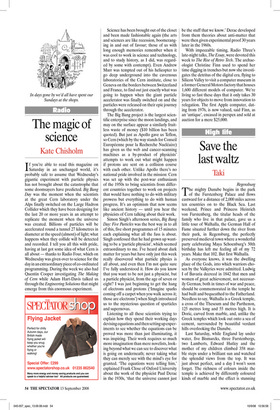The magic of science
Kate Chisholm
If you’re able to read this magazine on Saturday in an unchanged world, it’s probably safe to assume that Wednesday’s gigantic experiment with particle physics has not brought about the catastrophe that some doomsayers have predicted. Big Bang Day was the moment when the scientists at the great Cern laboratory under the Alps finally switched on the Large Hadron Collider which they have been designing for the last 20 or more years in an attempt to replicate the moment when the universe was created. Billions of particles will be accelerated round a tunnel 27 kilometres in diameter at the speed (almost) of light; what happens when they collide will be detected and recorded. I tell you all this with pride, having at last got some idea of what Cern is all about — thanks to Radio Four, which on Wednesday was given over to science for the day in an extraordinary piece of co-ordinated programming. During the week we also had Quentin Cooper investigating The Making of Cern while Adam Hart-Davis talked us through the Engineering Solutions that might emerge from this enormous experiment. Science has been brought out of the closet and been made fashionable again (the arts and sciences are like recession, boomeranging in and out of favour; those of us with long enough memories remember when it was cool to work in science and technology, and to study history, as I did, was regarded by some with contempt). Even Andrew Marr was tempted out of his helicopter to go deep underground into the cavernous laboratories of the Cern institute, close to Geneva on the borders between Switzerland and France, to find out just exactly what was going to happen when the giant particle accelerator was finally switched on and the particles were released on their epic journey through the accelerator.
The Big Bang project is the largest scientific enterprise since the moon landings, and may on the surface appear a similarly fruitless waste of money ($10 billion has been quoted). But just as Apollo gave us Teflon, so Cern (which by the way stands for Conseil Européenne pour la Recherche Nucléaire) has given us the web and cancer-scanning machines as a by-product of physicists’ attempts to work out what might happen if protons are sent on a collision course with each other. Unlike Apollo there’s no national pride involved in the mission: Cern was set up with the post-war enthusiasm of the 1950s to bring scientists from different countries together to work on projects that would have nothing to do with military prowess but everything to do with human progress. It’s an optimism that now seems like ancient history — until you hear the physicists of Cern talking about their work.
Simon Singh’s afternoon series, Big Bang Day: Five Particles was the best way in to all of this, five short programmes of 15 minutes each explaining what all the fuss is about. Singh confessed that he had grown up wanting to be a ‘particle physicist’, which seemed extraordinary to me. I’ve heard about dark matter for years but have only just this week really discovered what particle physics is all about, and even then I’m not quite sure I’ve fully understood it. How do you know that you want to be not just a physicist, but a particle physicist, from the age of seven or eight? I was just beginning to get the hang of electrons and protons (‘Imagine sparks coming off a carpet when you walk across it; those are electrons’) when Singh introduced us to the mysterious question of sparticles and supernovas.
Listening to all these scientists trying to explain how they spend their working days devising equations and then setting up experiments to see whether the equations can be proved was more than just illuminating, it was inspiring. Their work requires so much more imagination than mere novelists, looking beyond what we can see to discover what is going on underneath; never taking what they can merely see with the mind’s eye for granted. ‘The equations were telling him,’ explained Frank Close of Oxford University about the work of the physicist Paul Derac in the 1930s, ‘that the universe cannot just be the stuff that we know.’ Derac developed from them theories about anti-matter that were then given experimental proof 30 years later in the 1960s.
With impeccable timing, Radio Three’s late-night talks, The Essay, were devoted this week to The Rise of Retro Tech. The archaeologist Christine Finn used to spend her time digging in trenches but now she investigates the detritus of the digital era, flying to Silicon Valley to visit a computer museum in a former General Motors factory that houses 1,600 different models of computer. We’re living so fast these days that it only takes 30 years for objects to move from innovation to relegation. The first Apple computer, dating from 1976, is now valued, said Finn, as an ‘antique’, encased in perspex and sold at auction for a mere $25,000.










































































 Previous page
Previous page